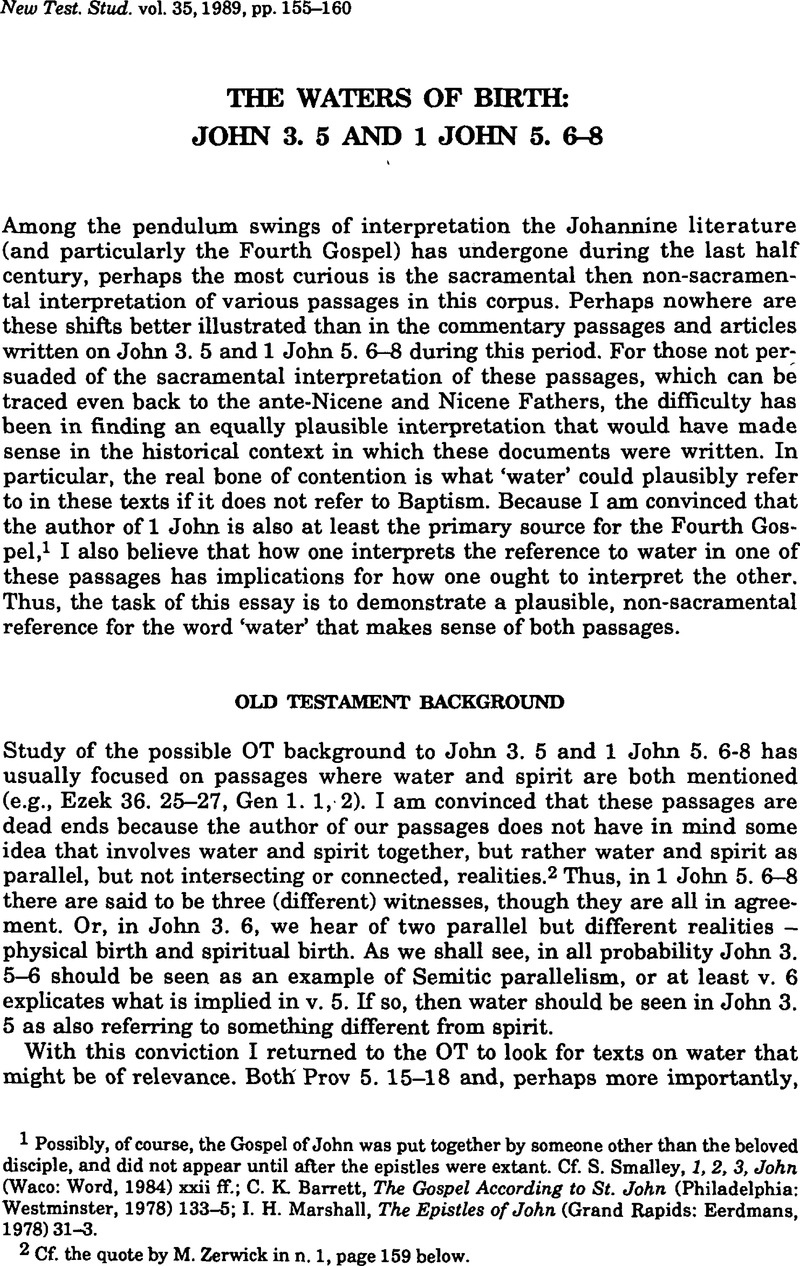Article contents
The Waters of Birth: John 3. 5 and 1 John 5. 6–8
Published online by Cambridge University Press: 05 February 2009
Abstract

- Type
- Short Studies
- Information
- Copyright
- Copyright © Cambridge University Press 1989
References
page 155 note 1 Possibly, of course, the Gospel of John was put together by someone other than the beloved disciple, and did not appear until after the epistles were extant. Cf. Smalley, S., 1, 2, 3, John (Waco: Word, 1984) xxii ff.Google Scholar; Barrett, C. K., The Gospel According to St. John (Philadelphia: Westminster, 1978) 133–5Google Scholar; Marshall, I. H., The Epistles of John (Grand Rapids: Eerdmans, 1978) 31–3.Google Scholar
page 155 note 2 Cf. the quote by Zerwick, M. in n. 1, page 159 below.Google Scholar
page 156 note 1 McKane, W., Proverbs (Philadelphia: Westminster, 1970) 319.Google Scholar
page 156 note 2 Cf. Ginsberg, C. D., The Song of Songs and Coheleth (New York: KTAV, 1970) 162Google Scholar; Pope, M. H., Song of Songs (Garden City: Doubleday, 1977) 496Google Scholar; Keil, C. F. and Delitzsch, F., Commentary on the Old Testament (Grand Rapids: Eerdmans, 1977 repr.) 6: 86–7.Google Scholar
page 156 note 3 Cited in Pope, , Song of Songs, 496–7Google Scholar; cf. 70 ff. on the dating of this material.
page 157 note 1 Odeberg, Hugo, The Fourth Gospel (Amsterdam: B. R. Gruver, 1968) 54–71.Google Scholar
page 157 note 2 Danby, H., The Mishnah (London: Oxford University, 1933) 339Google Scholar and n. 9. Barrett, , John, 209Google Scholar, appears to be the only modern commentator to mention this material cited by Odeberg.
page 157 note 3 Charlesworth, J. H., The Old Testament Pseudepigrapha (Garden City: Doubleday, 1983) 1: 517 ff.Google Scholar, here p. 542 with a translation by B. M. Metzger.
page 157 note 4 Odeberg, , Fourth Gospel, 56.Google Scholar
page 157 note 5 Charlesworth, , OT Pseudepigrapha, I: 261Google Scholar, and esp. note e, where other texts (Bab. Talm. Saab. 88b and Lev. R. 14. 2) are cited.
page 157 note 6 Ibid., I:315.
page 157 note 7 Notice how in Ps 139. 15 the womb and the earth appear to be synonyms for the place where a human being is made, though the reference to the earth could be to the creation of Adam. Cf. v. 13, however, and the reference there to the mother's womb.
page 157 note 8 Cf. Women in the Earliest Churches (SNTSMS; Cambridge University Press, 1988) 183–210.CrossRefGoogle Scholar
page 158 note 1 Stol, M., Zwangerschap en gebooorte bij de Babyloniers en de Bijbel (Leiden: E. J. Brill, 1983) 59 ff.Google Scholar, as cited in Pamment, M., ‘John 3:5, “Unless one is born of water and Spirit, he cannot enter the kingdom of God”’, NovT 25 (1983) 189–90.Google Scholar
page 158 note 2 Ibid.
page 158 note 3 ANET, 174–5Google Scholar (cf. Code of Hammurabi, sec. 185–191).Google Scholar
page 158 note 4 Stol, as cited in Pamment, , ‘John 3. 5’, 190Google Scholar, n. 1. Cf. Bauman, A., ![]() TDOT 4 (1980) 344Google Scholar, who points out
TDOT 4 (1980) 344Google Scholar, who points out ![]() can be used of the whole process of labour and birth.
can be used of the whole process of labour and birth.
page 158 note 5 Collins, John J., The Apocalyptic Imagination (New York: Crossroads, 1984) 135.Google Scholar
page 158 note 6 Cf. Pamment, , ‘John 3:5’, 189–90Google Scholar; Fowler, R., ‘Born of water and Spirit (Jn. 3.5)’, ET 82 (1970–1) 159Google Scholar; Spriggs, D. G., ‘The Meaning of “Water” in John 3.5’, ET 85 (1973–4) 149–50.Google Scholar This view appears to go back to Strachan, R. H., The Fourth Gospel, Its Significance and Environment (London: Macmillan & Co., 1920) 93 ff.Google Scholar, and seems to be alluded to by Hoskyns, E., The Fourth Gospel (London: Faber & Faber, 1932) 230–1.Google Scholar
page 159 note 1 Cf. Büchsel, F., ‘γεννάω’, TDNT 1 (1964) 671Google Scholar, where John 3. 5 is said to refer to birth; BAG, 154; Moulton, James Hope and Milligan, George, The Vocabulary of the Greek Testament (Grand Rapids: Eerdmans, 1930) 124Google Scholar; Zerwick, M. and Grosvenor, M., A Grammatical Analysis of the Greek New Testament (Rome: Biblical Institute, 1974) 292Google Scholar (‘be born’ with έκ ‘from’); Ringwald, A., ‘Birth’, DNTT 1 (1975) 179Google Scholar, points out the analogy with John 8. 42 where we have ‘come forth from’ (έκ).
page 159 note 2 Cf. the older translations of Westcott, B. F., The Gospel According to St. John (Grand Rapids: Baker Book House, 1980 repr.) 108.Google Scholar
page 159 note 3 Zerwick, M., Biblical Greek (Rome: Pontifical Institute, 1963) ser. 141, p. 47Google Scholar, where he says of John 3. 6: ‘…the use of the neuter lays down an absolute and universal principle based on the distinction and separateness, each in its own sphere, of the natural and super-natural orders.’
page 159 note 4 Cf. Morris, L., The Gospel According to John (Grand Rapids: Eerdmans, 1971) 213, n. 13.Google Scholar
page 159 note 5 Bultmann, Contrast R., The Gospel of John, trs. Beasley-Murray, G. R. et al. (Philadelphis: Westminster, 1971) 138Google Scholar and especially n. 3.
page 160 note 1 Cf. Marshall, , John, 232 ff.Google Scholar, and Smalley, , 1, 2, 3 John, 277 ff.Google Scholar As Smalley says, the use of όέλθών (‘the one who came’) suggests particular moments in history when these things happened, not ongoing and repeated sacramental realities.
page 160 note 2 On the second century interpretation of this passage as having to do with water baptism, cf. for instance, Martyr, Justin, First Apology, chap. 61.Google Scholar It is worth noting that he interprets ἅνωθεν in John 3 as ‘again’, referring to a second birth.
- 2
- Cited by


